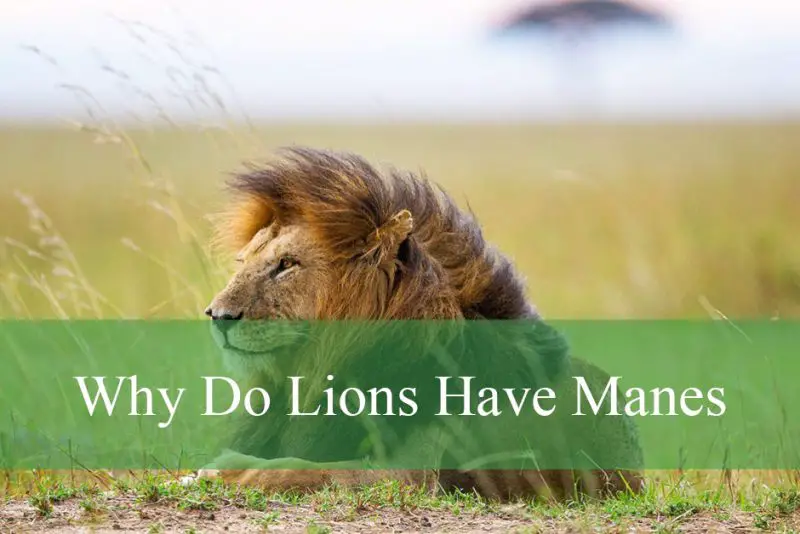Lions have long been recognized as symbols of strength, courage, and majesty, with the male lion’s mane serving as an iconic feature that distinguishes it from other big cats. The magnificent mane, often described as a crown of golden or dark hair surrounding the lion’s face, has fascinated scientists, wildlife enthusiasts, and the general public alike. But why exactly do lions have manes? Beyond their striking appearance, manes serve important biological, social, and evolutionary functions that reveal much about the nature of lions themselves.
This article dives deep into the reasons lions have manes, exploring the fascinating facts behind their purpose, meaning, and impact on lion behavior and survival. Whether you are curious about lion biology or simply intrigued by these regal creatures, this comprehensive guide will illuminate the many roles the mane plays in the life of a lion.
The Biological Significance of the Lion’s Mane

At its core, the lion’s mane is a unique physical adaptation that distinguishes male lions from females and other members of the big cat family. The mane is essentially a thick growth of hair around the lion’s neck, head, and sometimes extending onto the chest and shoulders. It begins to develop when male lions reach sexual maturity, usually around two years old.
From a biological standpoint, the mane is more than just an aesthetic feature. It reflects the lion’s health, age, and hormone levels. Testosterone plays a pivotal role in the growth and darkness of the mane. Male lions with higher testosterone levels tend to develop fuller and darker manes. This connection to hormones means that the mane can act as a visual indicator of the lion’s physical condition and virility.
The color and size of the mane also vary based on environmental factors such as climate and geography. For example, lions living in hotter climates often have shorter, lighter manes, which may help prevent overheating, while those in cooler regions tend to develop thicker and darker manes. This variation suggests that the mane has evolved to balance between the benefits of protection and attraction with the physiological demands of the environment.
How Manes Protect Lions in Fights
One of the most widely accepted theories about why lions have manes relates to protection during physical confrontations. Male lions often engage in fierce battles to defend their pride or challenge rival males for territory and mating rights. These fights can involve biting and clawing targeted at the neck and head — critical and vulnerable areas.
The thick mane acts as a form of natural armor, cushioning and shielding the lion’s neck and throat from wounds. By absorbing blows and reducing the severity of injuries, the mane increases the lion’s chances of surviving violent encounters. This protective function is particularly vital during territorial disputes and dominance challenges, which can determine the lion’s ability to lead a pride and reproduce.
The protection theory also explains why the mane is more developed in males. Female lions typically do not engage in the same level of aggressive fighting and therefore do not need this physical defense mechanism. This sexual dimorphism—where males and females exhibit different physical traits—highlights the mane’s importance in male-specific behaviors and survival.
The Mane as a Signal of Fitness and Dominance
In the complex social structure of lions, the mane serves as an important visual signal used for communication within and between prides. Male lions with larger and darker manes tend to be perceived as more intimidating and dominant by other males. The mane broadcasts information about a lion’s strength, age, and fighting ability without the need for direct confrontation.
From an evolutionary perspective, this signaling function benefits the lion by reducing the frequency and intensity of fights. Rival males are more likely to back down or avoid challenges against a lion with an impressive mane, thereby lowering the risk of injury for both parties.
Moreover, the mane plays a critical role in attracting females. Lionesses often prefer males with darker and fuller manes because such traits are linked to higher testosterone levels, better genetics, and greater ability to protect the pride. This female preference reinforces sexual selection pressures that have shaped the mane’s evolution.
Thus, the mane is not merely decorative but a key factor in reproductive success. It acts as a badge of honor that helps males assert dominance, deter rivals, and secure mating opportunities, thereby passing on their genes to the next generation.
Environmental Factors Affecting Mane Development
The development and appearance of the lion’s mane are influenced not only by genetics and hormones but also by the environment. Climate plays a particularly significant role in determining the size, thickness, and color of the mane.
Lions inhabiting warmer regions, such as the open plains of the Serengeti in East Africa, often grow shorter, lighter manes. This adaptation likely helps prevent overheating, as a thick, dark mane can absorb heat and raise body temperature. In contrast, lions in cooler areas or higher altitudes may develop more extensive manes that provide insulation against the cold.
Recent studies have also shown that factors such as nutrition and parasite load affect mane growth. Well-nourished lions with low parasite burdens tend to have more impressive manes, which further signals their superior health status.
Interestingly, some lions living in specific populations or geographic locations have almost no mane at all. For instance, the Asiatic lion, which inhabits the Gir Forest in India, displays a much less prominent mane compared to their African counterparts. This difference is believed to be due to environmental pressures and evolutionary divergence, showing how the mane adapts over time based on local conditions.
The Mane’s Role in Lion Social Behavior
Beyond physical protection and sexual selection, the mane also influences lion social dynamics. Lions are the only big cats to live in prides—complex social groups that involve cooperative hunting, territory defense, and raising offspring.
Within these social structures, the mane helps establish hierarchy and maintain order. Dominant males with impressive manes generally control pride leadership, and the mane’s prominence helps reduce the need for constant physical disputes. This visual cue promotes stability by clearly indicating which males hold power.
The mane also impacts interactions with females. Lionesses often use mane characteristics to assess the quality of males as potential mates and protectors of the pride. A healthy mane suggests a lion capable of defending territory and offspring from threats such as rival males or other predators.
Social bonds between males can also be influenced by mane development. Coalitions of related males with large manes tend to work together more effectively to defend prides and increase their reproductive success. The mane thus has implications for cooperation and alliance-building within lion societies.
The Evolutionary Journey of the Lion’s Mane
The lion’s mane is the result of millions of years of evolutionary pressures shaping the species. Fossil evidence suggests that ancient lions may have had manes, but their appearance and function have changed over time.
Natural selection favored males with manes because these features enhanced survival and reproductive success. Lions with more protective and visually dominant manes were better able to defend themselves and attract mates, passing on their traits to offspring.
At the same time, the mane’s evolution is balanced by environmental and physiological costs. Excessively large or dark manes could lead to overheating or make lions more visible to prey and rivals. Thus, the mane represents a compromise shaped by multiple factors acting simultaneously.
Modern lions continue to display this evolutionary trade-off. Research into the genetic mechanisms controlling mane growth reveals complex interactions between genes, hormones, and environment, illustrating how this majestic feature is finely tuned by natural forces.
Myths and Cultural Significance of the Lion’s Mane
Humans have long been captivated by the lion’s mane, often associating it with royalty, bravery, and nobility. Across cultures and history, the mane has symbolized power and leadership, inspiring art, folklore, and heraldry.
Many myths depict the lion’s mane as a crown bestowed by gods or as a magical attribute granting strength and protection. This cultural reverence parallels the biological reality of the mane as a mark of dominance and fitness.
Today, the lion’s mane continues to capture imaginations through wildlife documentaries, literature, and symbolism. Understanding the scientific reasons behind its existence adds depth to our appreciation of lions as both animals and icons.
Challenges and Threats Related to Mane Development
While the mane offers many benefits, it also comes with challenges for lions. Environmental changes such as rising temperatures due to climate change may affect mane growth, potentially influencing lion behavior and reproduction.
Additionally, habitat loss and human encroachment place stress on lion populations, which can impact nutrition and health. Poor conditions may lead to weaker manes, reducing males’ ability to compete and attract mates.
Conservation efforts aimed at protecting lions must consider these factors to preserve the species’ natural behaviors and traits, including the development of their iconic manes.
FAQs About Why Do Lions Have Manes
Why Do Lions Have Manes?
Lions have manes for several important reasons, including protection during fights, signaling strength and dominance, and attracting lionesses. The mane serves as both physical armor and a visual indicator of health and virility.
Do All Male Lions Have Manes?
Not all male lions have prominent manes. Factors such as climate, genetics, age, and health influence mane growth. Lions in hotter regions often develop shorter and lighter manes to avoid overheating.
Why Are Some Lion Manes Darker Than Others?
Darker manes are associated with higher testosterone levels, better health, and greater dominance. Lionesses tend to prefer males with darker manes because they are often stronger and better at protecting the pride.
Do Female Lions Ever Have Manes?
Female lions typically do not have manes, but rare cases have been recorded, often due to hormonal imbalances or genetic mutations. These maned females usually display more aggressive and dominant behaviors.
What Happens If a Lion Loses Its Mane?
If a lion loses its mane due to injury, illness, or poor health, it may be perceived as weaker by rivals and less attractive to females. The mane’s condition strongly influences a male lion’s social status and reproductive success.
Conclusion: The Mane as a Symbol of Lion Majesty and Survival
The lion’s mane is far more than a striking physical feature. It is a multifaceted adaptation shaped by biological, social, and environmental forces. Serving as protection in combat, a signal of fitness and dominance, and a critical factor in reproductive success, the mane plays a central role in the life of male lions.
Understanding why lions have manes reveals not only fascinating facts about their biology but also insights into their complex social lives and evolutionary history. The mane embodies the essence of lionhood—strength, beauty, and survival—making lions one of nature’s most iconic and admired creatures.






